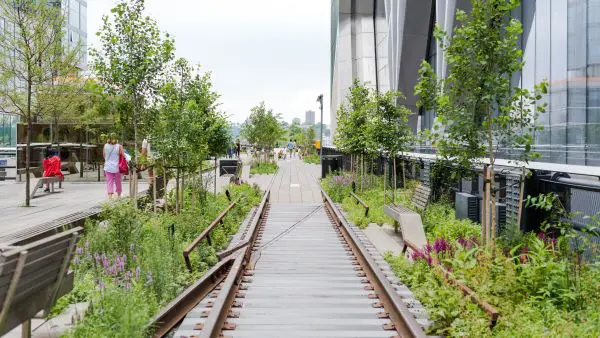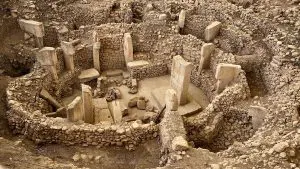What is adaptive reuse (and why is it important)?
Posted on: 1 May, 2024

Adaptive reuse has emerged as a sustainable alternative to demolition for the built environment. Here’s how it works.
The Göbekli Tepe is an archaeological site that was inhabited from 9500 BCE – over 10,000 years ago. Today, it has been partially excavated, and is located in Southeast Turkey. By many estimates, it’s the oldest man-made structure in the world.

While a particularly unique example, the Göbekli Tepe reflects the longevity of historic architecture, which was often designed to be used for hundreds, if not thousands, of years.
The same cannot be said for modern building stock in the 21st century. For steel structures, such as bridges, you can expect a lifespan of 100-150 years. For concrete and commercial buildings, the lifespan is less than 100, and often as little as 60 years.
Amid the launch of the United Nations’ Sustainable Development Goals, the longevity and lifecycle of modern buildings and the process of redevelopment have come under greater scrutiny.
As a major contributor to global carbon emissions, the built environment needs to play a central role in the push to net zero through the adoption of more sustainable alternatives to traditional demolition and redevelopment. And with recent instances such as the RAAC concrete crisis and the rejected Marks and Spencer (M&S) Oxford Street demolition putting ageing buildings in the limelight, new solutions are emerging.
One solution that has proven popular in sustainability discourse is the adaptive reuse model.
What is adaptive reuse?
Adaptive reuse is the process where existing buildings are reused in a different capacity to their original purpose. Buildings that undergo this process are usually at the end of their lifespan. Reusing them allows elements of their appearance, design, cultural heritage and historic significance to be maintained, while serving a new function and preventing them from being demolished in processes that consume a significant amount of energy.
Adaptive reuse vs retrofitting
Adaptive reuse projects are not the same as retrofitting. While both processes can offer significant sustainability benefits, retrofitting focuses on optimizing an existing building’s efficiency, consumption and waste generation, without addressing the use of the building itself. Reuse of buildings may involve elements of retrofitting, but it is instead focused on the repurposing of a structure for a different use. Both methods are increasingly popular and sustainable alternatives to demolition.
Learn more: To retrofit or not to retrofit: what’s the debate around the M&S Oxford Street demolition?
Why adaptive reuse projects are growing in popularity: 4 key benefits
It’s been said that three-quarters of the infrastructure that will exist by 2050 has yet to be built – a worrying statistic when you consider the amount of energy creating (and demolishing) buildings produces. In the case of the aforementioned M&S Oxford Street redevelopment, campaigners claimed as much as 40,000 tonnes of CO2 would be produced by the project.
As with retrofitting, reusing a building for a new purpose is a far more sustainable alternative than choosing to demolish and redevelop the existing site. While a new building might be more energy efficient, it can take 10-80 years to offset the amount of energy consumed in its construction.
There are other benefits of adaptive reuse projects, including:
1. Maintaining cultural heritage
One of the chief arguments against the M&S Oxford Street campaign was the loss of a historic building that, while denied listed status, carried cultural significance. The adaptive reuse model allows historical buildings and cultural landmarks to be maintained while they serve a new purpose.
2. Reduced construction costs
Adaptive reuse projects can often be significantly cheaper for a company than having to demolish and rebuild from the ground up. What’s more, adapting a building for a new purpose can be faster, too. You’ll also circumvent many of the legal, regulatory and political challenges of demolition projects (as Marks and Spencer experienced), depending on the location of the existing building.
3. Optimised energy consumption
It’s not just in the construction process that adaptive reuse is more sustainable than demolition and redevelopment. When repurposing a historic building, you also have the opportunity to convert the building with environmentally friendly heating, ventilation and air conditioning (HVAC) systems that make it more energy efficient and reduce running costs.
4. Helps combat urban sprawl
Instead of having to seek a new construction site further afield, adaptive reuse gives builders more choice and allows them to choose from existing sites that help reduce urban sprawl and offers them geographical advantages.
Learn more: How can we deal with urban sprawl?
The drawbacks of adaptive reuse strategies
While building reuse can offer benefits over traditional demolition projects, this process isn’t without its challenges and potential obstacles.
- Safety issues and hazards: Historicalo buildings that weren’t constructed to meet modern standards and regulations can have serious issues and potential safety hazards – with a case in point being the RAAC crisis. These can be costly and difficult to address.
- Achieving environmental standards: Similarly, to bring a historic building up to modern sustainability and energy efficiency standards can require significant upgrades and enhancements – all of which will increase the cost of your construction project.
- Legal and regulatory challenges: While increasingly favoured as an alternative to demolition, any building reuse will require approval from the relevant authorities, and you may find adapting your building to existing laws a challenging process.
5 types of adaptive reuse
Here are five different adaptive reuse strategies:
1. Facade
Facadism, or facadectomy, is a type of adaptive reuse where a building’s facade (front part or exterior) is preserved, while the rest, for example its inner structure, are demolished and modernised. While not a ‘true’ repurposing of a building, it’s viewed by many as being better than simply demolishing a building entirely.
2. Integration
In an integration, a new structure is built around the existing building, allowing the original structure to be maintained while enclosed in a new site. The historical building will still be modernised during this process in order to preserve it, and it may still be used for its original purpose.
3. Renovation
Renovation is a form of adaptation that seeks to modernise and replace elements of historical buildings that are in poor condition whilst maintaining their core structure and appearance. A great example of this is the Schuurkensstraat in Ghent, Belgium – a house dating from the late 19th century that, while optimised with modern enhancements, retains its original appearance.
4. Infrastructure
Historical buildings aren’t the only candidates for modernisation and repurposing – adaptive reuse interventions can also be applied to infrastructure, from bridges and viaducts to hangars and even grain silos.
5. Heritage conservation/preservation
In perhaps the most comprehensive form of adaptive reuse, built heritage conservation involves maintaining a building’s materials, facade, integrity and structure while making minimal renovations in order to modernise it.
5 examples of adaptive reuse projects
1. The High Line, New York City, USA
The High Line (pictured at top of page) is one one of the most famous examples of adaptive reuse, and an example of how this model can be applied to infrastructure as well as historical buildings.
Opened in 1934, this railway was opened to allow the transportation of items for the food industry, but once this method was replaced by the use of trucks around the 1980s, it fell out of operation.
Instead of demolishing this famous New York landmark, it was adapted into a park, opening in 2009 and ever since becoming a popular tourist attraction.
2. Jægersborg Water Tower, Copenhagen, Denmark
Another famous example of adaptive reuse is the Jægersborg Water Tower, Denmark, a popular landmark, when it was opened in 1955, sparked controversy for its design.
The former water tower now serves as both housing for students and a youth center, adopting elements of biophilic design, such as protruding crystals that help bring in natural light.
3. House of Vans, London, UK

The House of Vans is a ‘mixed-use creative venue’, housed underneath 150 year old brick arches that stemmed from a railway line heading out of London’s Waterloo station.
Today, it serves a variety of purposes and houses various facilities for fans of the famous shoe brand, from cafes and bars to music venues and even skate parks.
4. Wooden Structure at Launchlabs, Basel, Switzerland
Over in Basel, Switzerland, an assembly hall from a machine factory that was already being repurposed as an event venue is now in use as a multifunctional working environment.
Another example of a mixed-use environment, this environment is designed to fulfill a number of different purposes simultaneously, from co-working to offices, workshops and events.
5. Ghirardelli Square, San Francisco, USA
Ghirardelli Square was originally a chocolate factory established by Domenico “Dominigo” Ghirardelli in the 19th century. After the company was sold in the 1960s, theis historical building was repurposed into a shopping and restaurant complex.
This particular building adaptation is one of the first examples seen in the USA, and is an example of an adaptive reuse intervention that successfully maintained an important cultural space within the city whilst continuing to provide value to residents.
 6. Tai Kwun Heritage Centre, Hong Kong, China
6. Tai Kwun Heritage Centre, Hong Kong, China
It’s not just Europe and the USA that recognises the potential of adaptive reuse. In Hong Kong, a compound of heritage buildings, including a former police station, have been repurposed into open space – a rarity in a city so densely populated.
Final thoughts
The built environment is at the centre of the battle against climate change. While the construction process is one of the biggest contributors of manmade emissions, there’s a continuous demand for more infrastructure as the population grows and old, historical buildings reach the end of their lifespan.
All of this presents a conundrum for our sector, but far from being an insurmountable obstacle, we instead have an opportunity to influence change and drive sustainable practices. While it’s not a full proof solution, adaptive reuse is an alternative to demolition we should all be considering.
Sustainability isn’t a passing trend – it’s here to stay and is constantly evolving. If you want to inspire and action change in your career, UCEM’s MSc Innovation in Sustainable Built Environments will give you the skills you need, both now and in the future.
Find out more: MSc Innovation in Sustainable Built Environments – University College of Estate Management




 6. Tai Kwun Heritage Centre, Hong Kong, China
6. Tai Kwun Heritage Centre, Hong Kong, China

